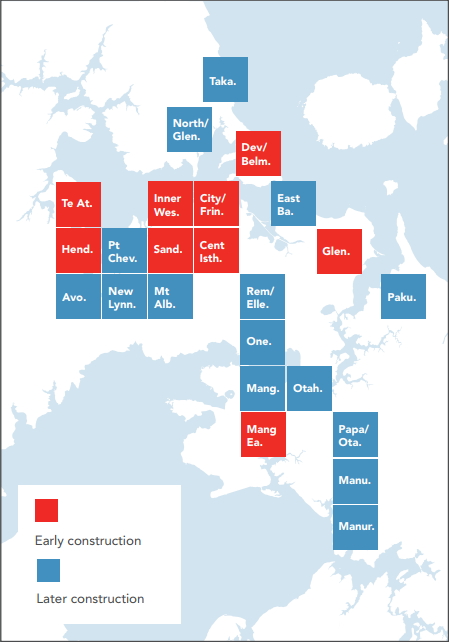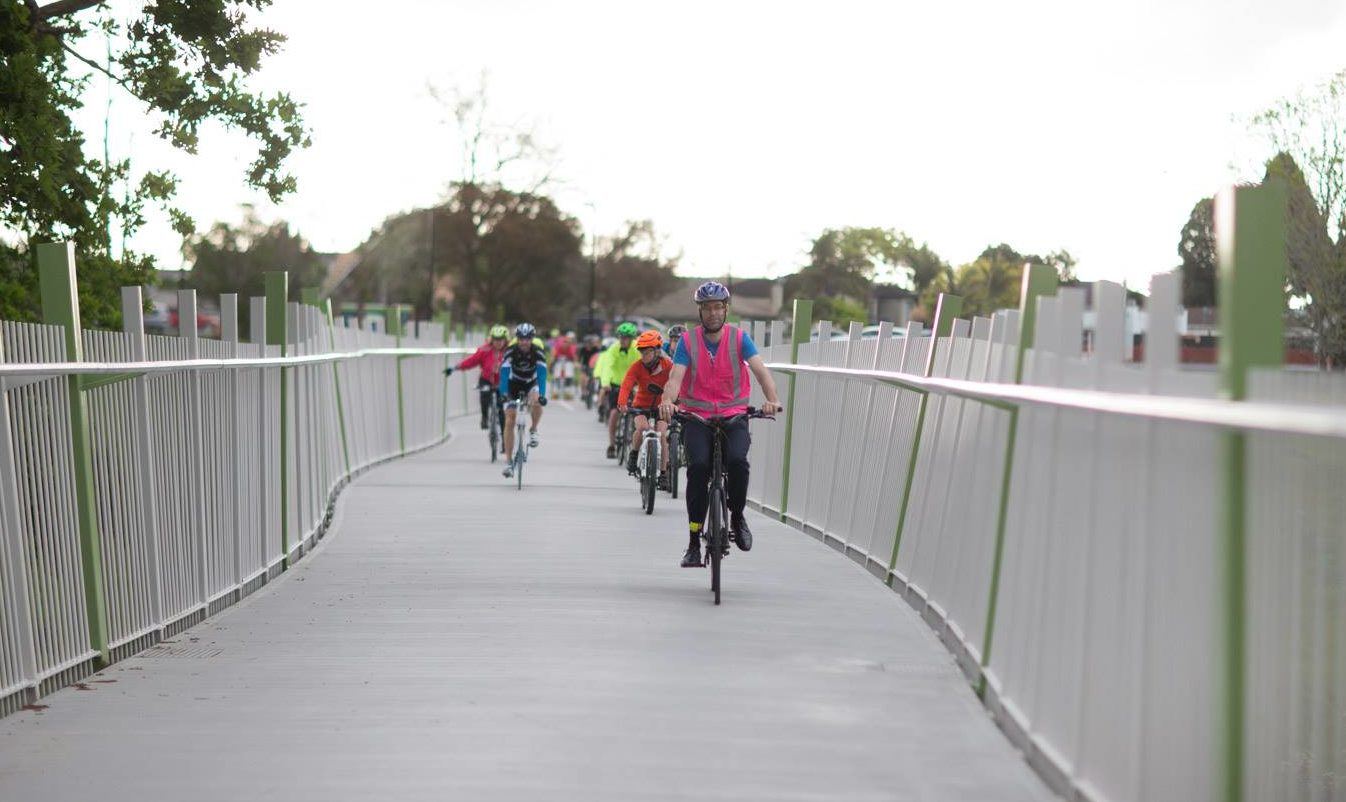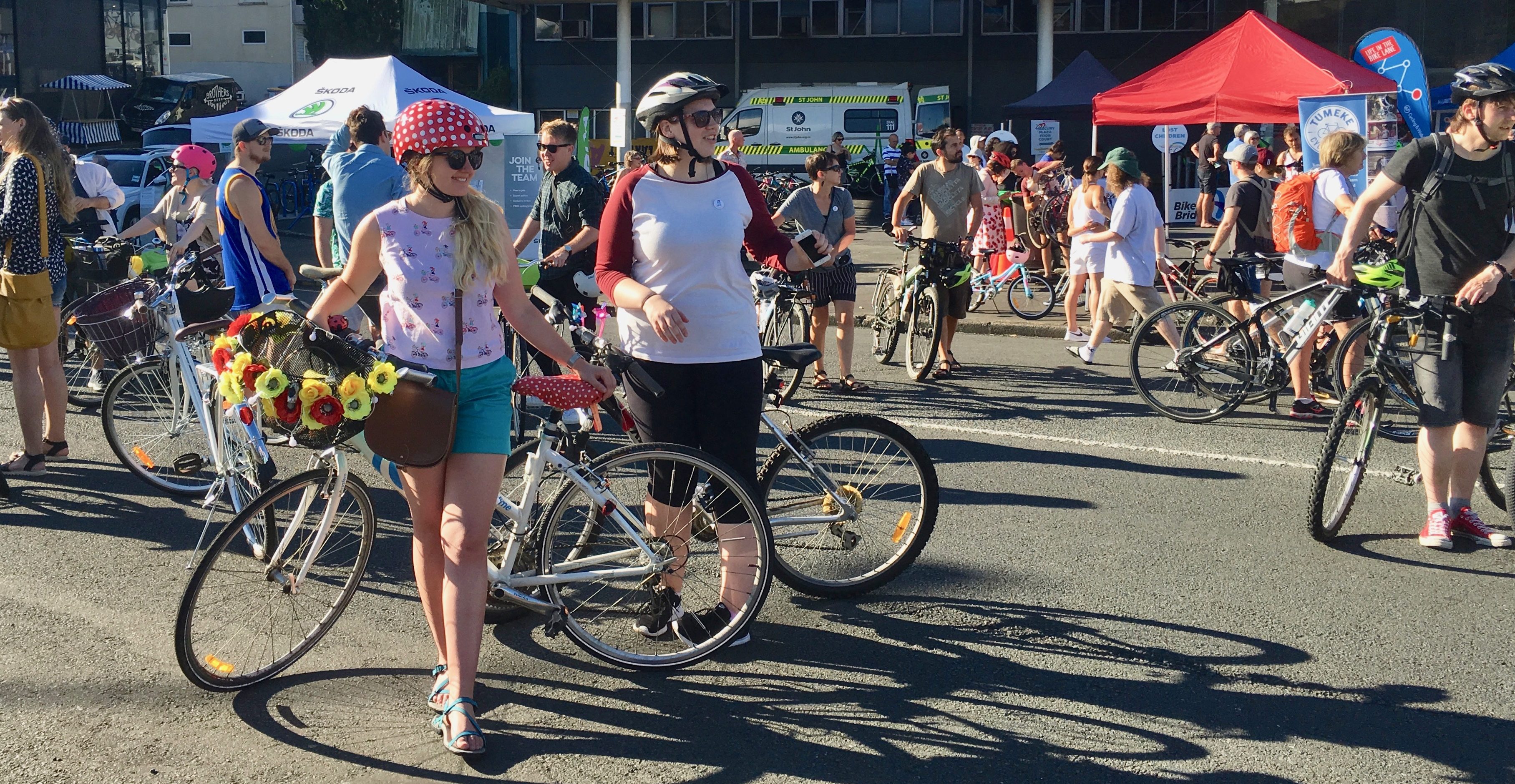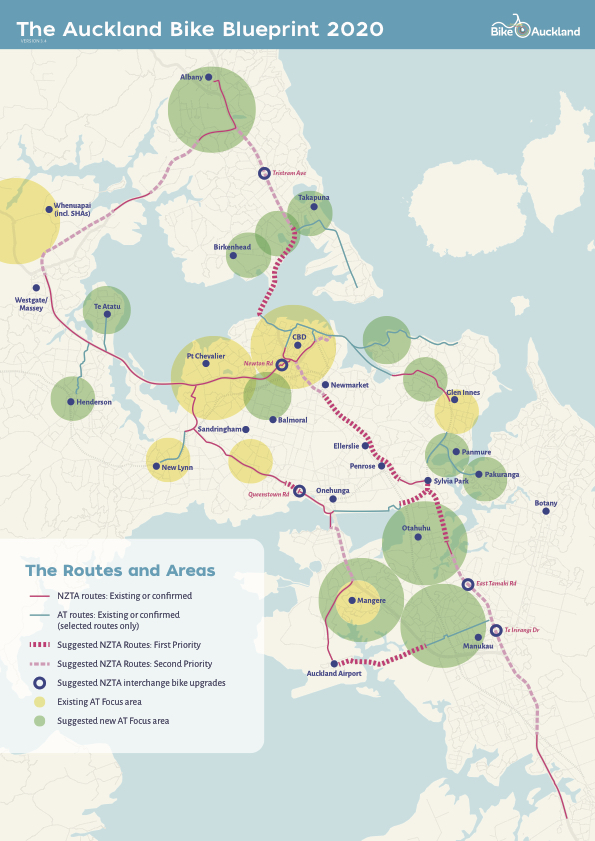Unless you’ve been totally out of media range, you’ll have heard about ATAP: a short acronym for the biggest change in AKL’s transport planning for decades, the Auckland Transport Alignment Project.
The news stories have focused mainly on public transport: all the new light rail lines, busways and other improvements on the way. On this score, our friends over at Greater Auckland deserve as much glory as the politicians in Government and Council for boldly articulating the kind of rapid and reliable transport network a fast-growing city needs in the 21st C.
Of course, our own eyes went immediately to what’s in ATAP for people on bikes. And the news is good! It also gave us cause to stop and think about how far Auckland has come for cycling in just three short years… how much still lies ahead… and what’s on the immediate horizon.
Grab a cuppa, and settle in for a three-part tour of the state of things – present, past, and future.
The Three A’s – All About ATAP
- 640 million dollars (over 10 years) for cycling infrastructure – including the highlight items of Skypath and Seapath, and a new walk/cycle bridge between Onehunga and Mangere! But that money will also fund many more local bikeways and protected bike lanes on arterial streets – routes to schools, work and play. Importantly, this means that cost increases on the not-yet-finished projects from the last years will be covered and that AT’s ambitious bike business case for future projects beyond them is potentially* fully funded. (We say ‘potentially’ because things may shift under the draft Regional Land Transport Plan – to learn more about that, go here.)
- 240 million dollars for Local Board transport projects – those would be your new footpaths, greenways, routes through parks, and local safety upgrades at scary intersections. Its true that this funding isn’t automatically going to active modes (some will call for it to go towards more car parking for the local shopping centre, for example). But it means that if you go to your Local Board with a smart idea to fix something, chances are a lot better that they will be able to fund it!
- 900 million dollars for road safety – this is a big, big chunk. Many a dodgy intersection will get improved from this funding, including some that have been on the to-do list for a long time – and we’ll be leading the call for all upgrades to include bike safety. As we’ve seen with recent cases – like a proposed Papatoetoe roundabout – bike safety is not yet automatically included. But we are getting there. The massive funding increases across New Zealand for safety are a step change. Even if it takes some years for the effect to be seen, the goal is to deliver a 60 per cent reduction in annual deaths and serious injuries across Auckland, from 813 in 2017, to no more than 325 in 2027. Those statistics cover a lot of people on bikes. And with streets becoming safer, more people will feel ready to hop onto two wheels.
Good, huh? And that’s not all! Because in addition to the dedicated bikeway funding, ATAP is jammed full of benefits for cycling in many other areas:
- Rapid transit projects – many of these will include additional walk and bike components.
- We’ve already had several meetings with AT about NW Light Rail, with a view to ensuring that the NW Cycleway is retained and upgraded when the light rail line is constructed along SH 16 towards Westgate (and later, Kumeu and Huapei) – and that the design includes new safe bikeways to the stations from the surrounding areas. Maybe we can even swing a few new underpasses: wherever light rail goes under or over at the motorway interchanges, it should be possible to make sure bikes don’t have to stop at the lights either. We’re keen to see whether we can get cycleway improvements at the city end, too.
- With the Dominion Road / Airport LRT project, it has proven much harder to make contact with the team inside AT. We know that they’ve looked at options that include bikeways – even though this will be tricky in the town centres – but it’s not yet clear to what degree they believe this is feasible or included in the funding. We’re keen to avoid a repeat of the previous busway plans, where bikes were shunted into Mt Eden’s back streets (although, ironically, those lower-cost back street bike routes were the only part of the Dominion Road corridor bus project that ever actually got built!).
- The ATAP announcement also includes funding for the next stage of AMETI – now called the ‘Eastern Busway’ – for the route between Panmure and Pakuranga, and then later onward to Botany. As we have raved about before, this includes some pretty sweet bikeways which, east of Panmure Bridge, are up to full best-practice separation standards.
- In the North, we have the Northern Busway extension to Albany, which will include some pretty significant new bikeways along both SH1 and SH18, providing more backbone routes for the Shore and access to the busway stations from the surrounding suburbs.
- The City Rail Link project originally didn’t include a great deal of thinking around bike access – an odd omission for a 21st C city. But we have been meeting with AT and the CRL Ltd. folks to upgrade bike parking around stations (including for the swathes of share-bikes that are the real sign of a multi-modal international city these days). And, as the new stations get closer to construction, we will also see the construction of nearby bikeway projects like K Road and the Victoria St Linear Park.
- Strategic and local road network – ATAP still proposes quite a lot of investment into roads (which was to be expected). Luckily, in 2018, brand-new roads simply don’t get built without bike infra anymore.
- The East-West Link – it’s back, although we don’t know where it will go (probably NOT onto land reclaimed from the Mangere Inlet), to the tune of a whopping 900 million dollars (!). Last time round, Bike AKL gritted our teeth and engaged vigorously in the Board of Inquiry process, despite our misgivings about the overall project – and we won 60 million dollars of additional bike funding, as well as 30 million dollars of added funding for bikeways outside the project boundary. Now we’re keen to make sure both proximate and connecting bikeways are included in the lower-cost version of East-West as well.
- Southern Motorway Widening (Papakura to Drury) – Again, not something we’re keen on in particular. But because we won’t let motorways happen without bikeways, we’ve been engaging with NZTA over the last year to make sure that the Southern Cycleway (currently being built from Takanini to Papakura) is extended to Drury as well. Even with e-bikes, few people will ride it all the way into the City Centre – but these new bikeways will let people access local train stations, and will help connect the local communities strung out along this corridor through the south of Auckland.
- Mill Road – previous ‘large scale’ plans for Mill Road had bike ‘lanes included in the design, and we spoke up to make sure that they were separated and protected. We’re confident that any bike facilities here will be built to a protected standard, but we’re not sure yet what the design for the first stage(s) of Mill Road – as funded by ATAP – will look like…
- Eastern Airport Access (State Highway 20B) – Again, not much is known yet about the design for the eastern route into the Airport. But we’ll campaign for proper bike facilities, as we won them on SH20A.
- Greenfield transport infrastructure – while a good chunk of Auckland’s growth will occur inside current urban areas like on the Unitec land (and indeed must occur there, if we are not to sprawl houses all the way from Silverdale to the Bombays!), a lot of new areas will also open up in what are now just fields and bush. Thankfully, as we can see in Whenuapai, these will be designed to a wholly new roading philosophy, with slow-speed back streets, and protected cycleways on the main roads. People living in these far flung new suburbs may have a long haul to get to town (even with new rapid transport routes) – but at least they can wave their kids goodbye in the morning with a good conscience as they send them off on foot and on bike to the nearby schools.
Overall, these changes will make Auckland massively more bike-friendly – with new bikeways, safer roads and cycling included as ‘par for the course’ on much of our new transport infra.
So how did we get there, and what will we see happening here in Auckland? And what happened to all the projects from the Urban Cycleway Fund that are still not open, let alone started?
The Three B’s – Bike Blueprint, Bikeable CFN, and Business Case
Back in late 2016, projects kickstarted by the Urban Cycleway Fund (UCF) were trundling along, with the first highlights like Quay Street and Lightpath already open. Amidst the glee and jubilation, Bike Auckland knew that the official 3-year funding was fast running out, and that we all needed to get our heads around what was next.
The UCF had succeeded as a one-off funding scheme – by offering a 2-for-1 deal (2 dollars of co-funding for every dollar that a Council put into a bike project), it managed to excite action around the country. However, it was already clear in late 2016, early 2017 – even before projects started running late – that future bikeway building needed to be put on a more solid footing. Both for financial confidence (rather than depending on a one-off scheme), and to ensure they could be supported against criticism, and continued despite local speed wobbles.
So Bike Auckland started the process off, by creating the Bike Blueprint 2020 to highlight suggested priorities for Auckland’s cycling investment in the post UCF years.
As you may remember, we suggested a two-track approach:
- The routes – the backbones of a vital citywide network, generally (but not all) along motorways or rail lines. We suggested prioritizing SkyPath and SeaPath, and a route from Newmarket to Penrose as the first stage of a ‘Southern Cycleway’.
- The areas – here we suggested a more holistic, fine-grained approach, a mix of protected cycle lanes on arterial roads, general traffic calming, and back street greenways. Rather than an A-to-B highways approach to cycling, we encouraged designers to think of the bikeability of whole suburbs, by creating local networks of sweet streets. We suggested a variety of focus areas – from expanding the work in the Central Isthmus to much greater investment in South Auckland.
We also did a lot of assessment (which you can read about in the blog). Did our proposals stack up when compared against a couple of key indicators? Where do people already cycle? Where would we be likely to get many more cycling in the (near) future? Where can we connect to existing infrastructure or projects already planned anyway? Where are the jobs, where do people live – and where will more people live in Auckand’s growing future, with all the new housing proposed?
The combined result of routes and hubs was the map below:
We presented our work to NZTA and Auckland Transport in February 2017. We received high praise, but also some comments along the line of ‘Well, that will be difficult!’ for proposals like the Southern Cycleway through the ‘Bike Bermuda Triangle’ of the Central Isthmus.
Some months later, Greater Auckland presented the second version of their Congestion Free Network. Their audacious challenge to supercharge Auckland’s PT wasn’t lost on us – because if there’s one thing that goes well with a PT feast, it’s walking and cycling for entrees and desserts.
So, with Greater Auckland’s permission, we expanded on their network with a visualised proposal showcasing how providing safe local cycling (and walking) would expand the reach of these new public transport routes across a much larger part of Auckland. The Bikeable CFN – shown below as a movie:
During this time, Auckland Transport, with input from NZTA, had begun their own, much more formal planning processes – creating what would become the Auckland Cycling Programme Business Case (official document here and a great summary article with some of the best graphics excerpted here).
Despite the rather dry name, the Cycling Programme Business Case is a celebration of the benefits of bikes, by the numbers. It includes setting out all about WHY Auckland should invest in bikes, HOW we should invest in bikes, also WHERE, and HOW MUCH? ($635 million over ten years was the ‘fully funded’ level).
The aim: to raise biking from the Auckland-wide average mode share of 1% to 5% by the end of the ten-year programme. (Note: the central suburbs were already knocking on 4% at the last census; so if the average citywide mode share including even the far-flung rural areas hits 5%, you can be sure the core areas will have much higher rates of everyday biking).
Bike Auckland provided a lot of input into AT’s business case, both during its creation and with work beforehand like our Bike Blueprint. So how did AT’s proposed investment areas stack up against our own proposals?
As you can see, there was a lot of overlap between what we suggested, and where the business case proposes to invest over the next decade. The initial focus will be a combination of areas where bikes are already seeing increasing use (such as the northern Central Isthmus and the City Centre) and new focus areas further out.
A decade is a long time, even if the DNA is now set to keep us going strong for the full duration. What’s on the immediate horizon? What kind of projects will we see in the next couple of years?
The Three C’s – Cycleway Fund Projects, Consultation, and Construction
The Urban Cycleway Fund, when it was announced back in 2014, was nothing short of revolutionary. For the first time, a large-scale fund aimed for widespread transformation by creating new networks for people on bikes. Bike advocates around the country were ecstatic, as were many in the communities where bikeways were planned.
As projects moved from announcement into design, consultation and construction, that initial head of steam was tempered. Some proposed projects turned out to be more complex than initially envisaged – and New Zealand simply lacked the smooth roll-out skills that other countries had gained over decades of building cycleways. We had a lot of skills building roads – but few in retrofitting bikeways into existing areas.
Meanwhile, the construction industry was (and still is!) booming, leading to budgets being blown left and right as contractors hiked prices, knowing that authorities could not simply choose a cheaper competitor. And then there were pockets of resistance by people passionate about car parking, concerned about tree relocation, or simply opposed to bikes in cities, full stop.
Instead of building a whole network in three years, Auckland managed some very high profile successes – Lightpath, Quay Street, and the Waterview path; some mixed or partial results like the Northcote Safe Cycle Route and Mangere Future Streets and Stage 1 of Glen Innes to Tamaki Drive; and a few that ground almost to a halt despite general local support – like the Grey Lynn routes.

Meanwhile, other routes haven’t even broken ground yet, from K Road, to Tamaki Drive, to the New Lynn rail path. Others seem to have quietly dropped off the radar, like the Parnell route.
Over the last year or so, even before the temporary halt on the Grey Lynn routes, AT and others have been reconsidering how to approach the bike programme. Projects were (and are) being reviewed to make sure they are fit for purpose. There seems to be a move away from ‘cheap and cheerful’ projects (or ‘cheap and nasty’, if you’re a critic). Bikeways will now include more urban design, more streetscape enhancements. Think: more K Road Upgrade and less St Lukes Rd plastic paddles. More quality, in short – but also more time and money to get back on track.
There will also be an even greater effort made to communicate the wide community benefits of the projects – which surely will be easier when bikeways come with a whole host of extra streetscape improvements.
The short-term result is that for the next 2-3 years, construction will be mainly be about finishing what the Urban Cycleway Fund began. So we’ll see the completion of projects like K Road, and the Glen Innes to Tamaki Drive path (plus the Tamaki Drive upgrades themselves). Others, such as the Grey Lynn routes, and the Great North Road route, will be built to a much higher standard than originally consulted on.
So we’ll see a lot of new bikeways opening in the next couple of years – have no fear. But they’ll be those we’ve already heard about. It’ll mainly be catch-up time, delivering on past promises.
At the same time, AT will start engagement – as they already have in Henderson, for example – on the projects to come beyond the next 2-3 years, i.e. in 2021 and beyond. We expect this might lead to some ‘consultation fatigue’ among those of you who’ve always supported bike projects but are frustrated they haven’t yet arrived in your suburb, despite constant messages (including from us) that they’ll surely arrive soon. ‘Just build it already!’, you’ll be thinking.
But take heart – the lessons learned and the new funding are what will ensure those bike projects do arrive. In the legendary words of our Rachel: ‘It won’t happen overnight – but it will happen.’
At the end of the Urban Cycleway Fund, and at the beginning of the step-change that ATAP represents, we’ve learned a lot of lessons. Changing a city isn’t fast or easy. But the direction is stronger than ever before. The winds of logic are pointing the right way, and the stars – as well as the politicians and delivery agencies – are aligned.
For New Zealand, building urban cycleways is no longer a one-off experiment; it’s a path to the future. Auckland will become more of a bike city with every month, and every year.
March 2018 was Auckland’s busiest month ever on our cycleways. A record breaking 430,000 cycling trips were recorded in March, that’s 50,000 more cycling trips compared to last year. An increase of 13.5%! ??? #AKLBikeLife pic.twitter.com/7yNU60y0ra
— Auckland Transport (@AklTransport) April 17, 2018






